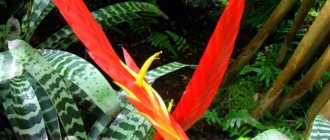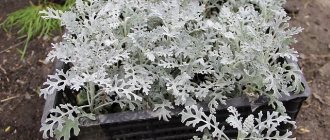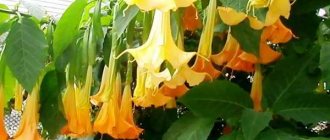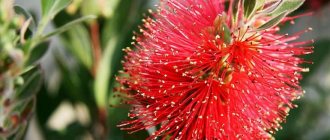This is a decorative indoor specimen no more than 30-50 cm high, characterized by long-term abundant flowering, various shades of inflorescences and original leaf color.
The homeland of Koleria is the north-west of South America; more than 60 of its species are currently known. At home, the plant has a weak growth rate, but pleases with its beauty for more than 3 years, after which the plant requires rejuvenation. Thus, the flower lives for a long time and is considered a perennial.
Be sure to pay attention to such wonderful plants as nematanthus and smithiantha.
| Low growth rate. |
| Blooms from late spring to early autumn. |
| An easy plant to grow. Suitable even for a beginner. |
| Perennial. |
Useful properties of koleria
Koleria is a safe, non-poisonous and absolutely non-allergic flower that is able to purify the air of impurities, traces of smoke, dust and toxic compounds. The plant saturates the surrounding space with oxygen, ionizes and refreshes the air.
Therefore, it can be considered an ideal option for placement in a nursery, bedroom, or kitchen.
Breeding
The extreme diversity of breeding varieties of Koleria is ensured through interspecific crossings.
Ampallang
Peculiarities:
- A compact variety that pleases with an abundance of large pink flowers with a light throat and petals covered with countless purple specks.
- Brown veins are clearly visible on the elongated leaves.
Low maintenance requirements are the reason for the incredible popularity of this variety among indoor floriculture lovers.
Vivian
Elegant bushes of the Vivian variety have:
- Small dark green leaves.
- Medium-sized flowers, bright pink. The white limbs of the petals, which have a wide edge with tiny dots, are covered with pinkish specks and strokes.
Beethoven
A bush strewn with red-orange flowers with petals whose limbs are dotted with many dark dots will delight its owners with long-lasting luxurious flowering. The beauty of the flowers is especially noticeable against the background of bright green leaves, decorated with a spectacular red border.
Brimstone
Quite a rare variety with bright orange flowers, whose petals on the lapel are decorated with tiny cherry specks that stand out effectively against the golden background. The two upper petals, painted in pinkish-lilac tones, have cherry specks. Brownish, pubescent leaves have a velvety surface.
Bibby
A plant, all above-ground parts of which are covered with thick soft fluff. The showy lantern flowers, hanging from erect stems with drooping bright green leaves, have elongated pink tubes, a bright yellow throat and petals with white flaps decorated with pink streaks and cherry flecks. Bushes that are not shaped can grow very tall.
Sunny
An incredibly decorative variety (by Mike Kartuz), bred in 1974, characterized by luxurious and long-lasting flowering. Peculiarities:
- The compact bushes of this truly sunny plant are literally strewn with bright yellow flowers. The flap of each petal is decorated with red strokes and dots radiating from the throat in the form of rays.
- The moderately green leaf blades, the edges of which are cut by many small teeth, are very different from the colors of all other varieties.
A properly tied bush can create the impression of a beautiful bouquet consisting of a large number of spectacular flowers.
Having become familiar with the characteristic features of the most popular varieties, lovers of indoor floriculture will be able to choose exactly the type of flower that is ideal for a specific interior.
If you find an error, please select a piece of text and press Ctrl+Enter.
Koleriya: care at home. Briefly
Koleria at home is such an unpretentious plant that it will delight any novice gardener. Basic nuances of flower care:
| Temperature | Not lower than 20-23 ºС in the summer season, in winter the optimal temperature is 15-16 ºС. |
| Air humidity | Requires high air humidity, at least 70%. |
| Lighting | Indirect sunlight, supplementary lighting on cloudy days. |
| Watering | Abundant moisture with soft filtered or rain water, but avoiding stagnation of moisture in the roots. |
| Soil for coloring | Slightly acidic, drained. |
| Feeding and fertilizer | Liquid fertilizing from the very beginning of the growing season. |
| Coleria transplantation | It is enough to replant once every three years. |
| Reproduction | Seeds, cuttings, leaves, as well as dividing the rhizome. |
| Features of cultivation | Should be protected from drafts and sudden temperature changes. The strong root system of Koleria can survive short-term drought. Regular pruning is required. |
Briefly about cultivation
- Flowering: from July to November.
- Lighting: bright diffused light.
- Temperature: in summer and spring – 22-26 ºC, in winter the plant is comfortable at 16-18 ºC.
- Watering: in spring and summer - frequent and plentiful, in autumn watering is gradually reduced, and in winter it is watered only so that the earthen ball does not dry out at all.
- Humidity: normal for residential premises. In hot weather, the pot with the plant is placed on a tray with wet expanded clay.
- Feeding: from April to October once a week with fertilizer for flowering plants.
- Dormant period: from November to March.
- Replanting: as needed at the beginning of active growth.
- Substrate: 2 parts turf soil, 4 parts leaf soil, 1 part humus and sand each.
- Reproduction: seeds and cuttings.
- Pests: scale insects, spider mites, whiteflies, thrips and mealybugs.
- Diseases: due to improper care or maintenance, the plant may have problems with leaves and delayed flowering.
Read more about growing koleria below.
Caring for coles at home. Details
Coleria flowering
Koleriya blooms very luxuriantly and for a long time - until late autumn.
The second name of the flower, “Colombian bell,” is fully justified by the appearance of the inflorescences in the form of elongated tubes with five petals at the ends. In addition to the rich color from rich fuchsia to soft lilac, the flowers of the koleria are “decorated” with small spots or stripes. Hybrid forms can have the most incredible shades, for example, brindle or golden color. Koleriya is ideal for overhead growing and looks great in hanging flowerpots and flowerpots. For successful flowering, it is enough to provide the plant with abundant regular lighting and a fairly tight flower container.
Temperature
Homemade koleriya is a heat-loving flower that develops safely in normal room conditions at a temperature of 23-25 ºС. With the onset of cold weather, the plant goes to winter at 15 ºС. But there are varieties that do without a resting stage and therefore, even in winter, they maintain the usual conditions of detention.
Spraying
Koleria needs high air humidity, but does not tolerate moisture getting on the leaves or flowers. That is, spraying is not the most successful option for caring for a plant.
To maintain the necessary balance of humidity in a room with a hue, it is advisable to use special room humidifiers. Or spray the space near the flower with a spray bottle.
Lighting
At home, the koleria plant prefers well-lit corners, south-facing windows with slight shading, or glazed sunny loggias. The plant is very light-loving, but it should be protected from scorching rays. In winter, the flower requires additional illumination with lamps for at least 12 hours a day.
Watering the koleriya
During the flowering period, the plant is given fairly frequent watering, but only if the soil surface has dried out a little.
Severe waterlogging also harms the flower, as does lack of moisture. In addition, watering the koleria must be done very carefully, avoiding water getting on the plant itself. As an alternative to classic watering, you can use moistening through a tray, as well as periodic loosening of the soil. In winter, watering is reduced to a minimum, only to moisten the earthen ball at the roots.
Kohleria pot
To grow koleria, experienced gardeners recommend choosing shallow, wide containers with a diameter of 20-25 cm. Very often, being in a pot that is too spacious is the reason for the lack of flowers in the plant, since in a large container the flower actively develops only the root system.
For very young varieties, pots with a diameter of 6 cm are sufficient.
Priming
The flower requires slightly acidic, loose soil, with a small amount of nutrients. If you take a home-made substrate, it can consist of the following components:
- sheet soil (2 parts)
- coarse sand (1 part)
- peat (1 part)
- humus (1 part)
Also suitable for koleria is universal soil for Saintpaulias and Gloxinias. A prerequisite is good drainage of the substrate.
Feeding and fertilizer
Koleriya at home needs systematic feeding, starting from April - the time of active development, and ending in mid-autumn. Most often, liquid fertilizer is used, containing a large amount of phosphorus, which promotes lush flowering.
Complex additives intended for orchids and violets are also suitable. All products are diluted in half the proportion indicated on the package.
Transfer
Koleriya is transplanted every three years in early spring after the end of the dormant phase.
Starting the procedure later, during the period of bud formation, is a big mistake, since in this case the flower will simply shed its ovaries and flowering will not take place. It is recommended to replant using a transshipment method, without shaking off the rhizomes and, if possible, without disturbing the earthen lump.
Trimming
Koleria is a universal flower that looks equally good both in the form of a bush and as an hanging plant. You can give it the desired look with the help of regular pruning, which not only shapes the crown of the flower, but also rejuvenates it. Basic rules for pruning:
- carried out in the spring, before the beginning of the growing season;
- damaged or dried shoots are removed with a sterile instrument;
- when the erect form of the flower is formed, all branches that have reached a length of 20-30 cm are shortened by about a third;
- To stimulate the growth of young lateral shoots and, accordingly, the formation of more buds, it is recommended to shorten all the tips of the shoots.
Timely pruning will increase the number of inflorescences and give the flower a well-groomed appearance. And on the contrary, if you exclude this measure, the branches of the plant will stretch out unsightly, and there will be significantly fewer flower stalks.
Rest period
Caring for koleria at home often involves providing the flower with a dormant period - the time when the plant stops growing and sheds its foliage in order to restore strength for the next development cycle. Depending on the variety, some varieties overwinter together with the foliage, bloom and require regular watering, while there are those that require complete rest - no fertilizing, extremely rare soil moisture.
If, with the onset of cold weather, the leaf turgor of a flower changes and begins to dry out, this plant needs rest. All wilted areas are completely removed, the bush is placed in a cool, moderately lit place, and until January, caring for it only includes lightly moistening the earthen clod.
Transshipment and transfer
Koleria prefers loose soil. You can use soil for violets or prepare it yourself from leaf soil, peat and sand (2:1:1).
Koleria prefers loose soil
The main part of the roots is close to the surface, so choose a shallow and wide pot. Material: ceramics, plastic. In clay dishes, moisture evaporates more slowly, and the roots overheat less. Drainage is laid at the bottom with a layer of 2 cm.
Select a pot that is shallow and wide
Transshipment takes place in early April.
- Half an hour before transplanting, water the flower.
- Carefully remove the plant along with the soil.
- Carefully inspect the roots and remove damaged areas.
- Divide the overgrown rhizome into parts.
- Place drainage at the bottom of the pot and sprinkle the prepared substrate on top.
- The plant is planted, covered with soil, and watered.
In an overly large pot, the plant will direct all its forces to the development of the root system.
It is not advisable to replant the flower while buds are setting and flowering.
After purchasing it in a store, the “furry pet” needs to get used to the new conditions. Then it should be transplanted. When transplanting, the rhizome is inspected, the young shoots are seated so that they do not crowd each other.
- The plant is removed from the pot.
- Completely free the roots from the earthen coma.
- Inspect the root system, cut off dry or rotten areas, sprinkling the cut areas with ash.
- Pour fresh substrate into a container with drainage.
- Plant a plant and water it.
- At first, they look after the transplanted flower and shade it from the scorching sun.
- A healthy plant in good soil will soon take root.
With age, koleria forms hanging shoots and can grow in the form of an ampel. If you grow it in the form of a bush, decorative support is often used to fix the shoots. You can put a thin stick in the pot and tie up the stems, or choose stands in the form of rings that will hold the overgrown adult plant well. If you fix the upper part of the flower on a holder, the lower shoots, falling, form a beautiful cascade.
You can put a stick in the pot and tie the stems
Growing Koleria from seeds
It is worth considering that when propagated by seeds, a flower most often does not retain its varietal characteristics. It is recommended to sow koleria in February. To do this, flower seeds are distributed into a low, wide container with special soil for Gesneriaceae without embedding.
Then the crops are covered with polyethylene or a glass cap, placed in a warm place and after the first shoots appear, daily additional lighting is organized. If there are several strong leaves, the plant is planted in separate pots with a diameter of 6-7 cm. Before the bush is formed, the seedlings should be pinched at the tops to stimulate the growth of side shoots.
Propagation of koleria by cuttings
A simple and quick option for breeding koleria is propagation by apical shoots. For this purpose, the cut tops of the bush are treated with stimulants and placed in a special soil, or a peat-sand mixture of about 2 cm. After 14 days, the first roots appear, and in a month it will be a full-fledged plant with a developed root system.
Since the “Colombian bell” is characterized by a high rate of root formation, the flower takes root successfully in water.
Propagation of coleria by division of rhizomes
When transplanting a flower, you can try to propagate it by dividing the root - the rhizome. The rhizome of a healthy adult plant is suitable for this, since it has several buds, nodes, and scaly growths that can produce full-fledged shoots when divided.
Having divided the rhizome into several parts, each of them is sprinkled with coal and allowed to dry. Then the roots are planted in separate containers and watered regularly. This method of propagation allows you to obtain a stronger, stockier, profusely flowering plant that is not prone to stretching.
Diseases and pests
The main problems that gardeners face when growing flowers are:
- koleria does not bloom in a pot that is too spacious, or when there is insufficient light;
- dark spots on the leaves will appear when watering with hard or cold water;
- Kohleria leaves turn pale or yellow as a result of poor lighting and frequent drafts;
- Kohleria leaves curl in rooms with low humidity;
- leaves wither when rotting areas appear in the root system, this may also be a signal that the plant requires a period of rest;
- light spots on the leaves (powdery mildew) - a fungal disease that often appears in conditions of high humidity or an excess of nitrogen fertilizers;
- gray plaque on the leaves (oidium) is caused by a fungus that spreads throughout the plant due to sharp fluctuations in temperature and humidity;
- koleria often drops buds due to excess calcium;
- Koleria shoots became bare due to an acute lack of sunlight;
- grows slowly, buds fall off when there is a lack of nutrients in the soil;
- Koleria leaves turn yellow if the flower is often exposed to the rays of the scorching sun, or if there is an oversaturation of fertilizers.
Pests of Koleria are aphids, mealybugs and spider mites.
Types of domestic varieties with photos and names
Koleria is a little popular flower in our latitudes. But still, the following varieties are common in indoor floriculture:
Kohleria amabilis (lat. Kohleria amabilis)
The flower is characterized by brown-green foliage with silvery fibers, shoots 40 cm long, and speckled petals of all shades of pink.
Linden's Kohleria (lat. Kohleria lindeniana)
A fairly compact type of plant, 20 to 30 cm high, with two-color foliage and contrasting veining, large light lilac flowers up to 6 cm in size.
Fluffy-flowered kohleria (lat. Kohleria eriantha)
It has rich green leaves with dark red edges and orange or purple buds that point downward.
Hairy Kohleria (lat. Kohleria hirsuta)
It is distinguished by purple-tinged foliage, as well as red flowers with a yellow border along the edges of the petals.
Kohleria bogotensis (lat. Kohleria bogotensis)
The tallest plant among the kolerias - up to 60 cm in height, with white-red pubescent shoots, single or double axillary red-orange inflorescences with a yellow throat.
Description
Koleria is a genus of plants in the Gesneriaceae family, numbering more than 65 species. It grows in the tropical forests of South America, in the shade of tall trees.
Koleria grows in the tropical forests of South America
The generic name was given in honor of the 19th century scientist. M. Kohler. Popularly known as the Colombian bell and the Colombian beauty.
The flower is popularly called the Colombian bell
Velvety elongated leaves with rounded teeth amaze with their richness of colors: green with red veins, olive with light veins, with white or reddish pubescence.
Different species have different foliage sizes and shades.
Bright bells appear among the foliage on thin peduncles. Corollas with a tube reach 5 cm. Some flowers look like thimbles.
The tube of the bell-shaped corollas reaches 5 cm
The color palette of the buds surprises with the variety of shades: pink with a speckled white throat, orange with a yellowish spotted throat, brownish with a light pattern inside.
The colors of Koleria flowers are varied
Colerias are much easier to keep in an apartment than other members of the family. They are undemanding and quickly adapt to the usual conditions of a residential building.
Spectacular colors easily adapt to normal indoor conditions











